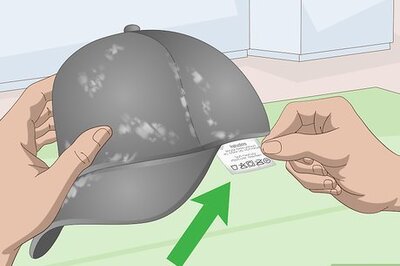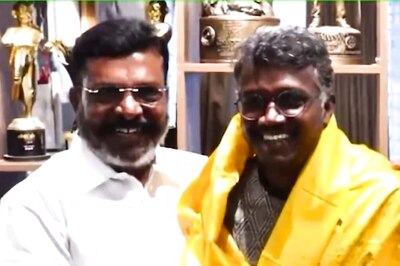
views
Preparing the Casebook entries.
Prepare a binder. Grab a binder. Although in Ghost Story they used a 2-ring binder, you can find a three-ring binder, but ensure you supply it with an adequate amount of paper: either lined or unlined is okay.
Ensure you can watch episodes in their entirety. Episodes only watched in part weren't fun to solve if you didn't watch them sequentially. Original airings took place every Sunday from 10/4/92-5/16/93, 9/12/93-4/24/94, and 9/25/94-2/12/95 although piecemeal episodes often contained missing casebook information, so lots of information was missed. According to Wikipedia, although Ghost Story and To The Light had five episodes, most of the other stories wrapped after four episodes.
Learn about each story. Most stories contained a mystery to solve, on top of an everyday "diary" of what happened and when. The details in this article, including those below, present a summary of the layout of one of the episodes, with you needing to fill in the remainder of the details. Especially in Ghost Story, you'll begin meeting the team members. At first, you'll learn about two middle schoolers from Brooklyn, NY named Jamal Jenkins and Lenni Frazier who meet Ghostwriter (later known as GW), and there's a weird case going on with backpacks being stolen. By the end of the first episode, you'd find there isn't yet enough information to figure out the case. By the end of the second episode, you'll meet Alex and his younger sister Gaby Fernandez. But by this same episode, you'll also spot the first signs of Ghostwriter's messages being understood. Ghostwriter also earns his name in this episode, and you'll start to see the beginnings of the case fall into line. Ghostwriter picks up words near another stolen backpack, and we begin gathering other pieces - the Double Defenders tournament and two-headed people. We also learn about Tina Nguyen, but we don't meet her until the next episode—she doesn't become a team member until other storylines. As the team goes through To Catch a Creep, the team also meets Rob, a writer who bobs in and out throughout parts of seasons 1 and 2 but upends for the 3rd and final season. By the end of the third episode, we learn about Ghostwriter's reading patterns and how he responds. We also learn about the first sightings of the Ghostwriter notebook, and figure out what types of stores sell THABTO buttons, with Calvin Ferguson who's a near-genius. They see signs about ordering personal buttons which they note as evidence, along with some special order details for THABTO buttons at this same store. We learn about other THABTO members through the messages about locker numbers, as Alex tries to crack the code. By the end of the fourth episode, we have our locker buddy noted - and Alex thinks he knows them, along with making notes about the Double Defenders Tournaments and everything he hears. He's descriptive, while also keeping notes. We learn about the origins of RALLY - from the Help Jamal messages on the computer, and we also figure out more about these Double Defenders players - keeping one away from the secret meeting that they were planning. Ghostwriter Team goes on the mission to double-cross the Double Defenders, but that doesn't work well, as we learn their sign-in ceremony and the origins of THABTO. By the end of the fifth episode, we see the team decoding the sign-in ceremony - seeing what they can learn - and they see a pattern and relationship to the backpack thieves and the meaning of THABTO! This case is nearly solved; Alex and Jamal go to the police and the team watches this Defenders Tournament. Jamal forms the first meeting of the Ghostwriter Team - and buys pens for each Team member. They have their first meeting to induct all the first members.
Working on the Casebook entry.
Open your binder to a blank sheet of paper. You can generally get this done on a few sheets of paper for one entry so you must get to a clean sheet of paper with nothing else on it. You can also prepare the casebook entry on a computer, but you'll later have to print out your entry, so a printer with ink would be necessary to compile the information.
Label the case by the case title. At the top of the page, label it with the episode's case title. Before all the episodes, they mentioned the case name. However, you'll need to label, underline, and center it. As with the first storyline, label it Ghost Story, but in the case of papered entry pages, these will need to be underlined. There were a total of 18 story arcs within the three-season run of Ghostwriter, so there is a lot of potential information and misinformation of what happened during each story. According to the Ghostwriter episode guide, contained here, they say that though Who Burned Mr. Brinker's Store storyline was second in the series, it was supposed to be the pilot episode based on the age of the team being younger.
Gather the clues yourself. In the case of Ghost Story, there's the weird coded message/note - especially from the very beginning, along with the THABTO button. Ghostwriter always reads words he can read and often highlights these as clues/messages to stand out to team members.
Label the sections you'll need. According to episode 2 of Just in Time (from Season 2), ensure you put together certain pages. You'll need to gather your list of Suspects and Evidence, but also gather your list of Other Clues. During Just in Time, the Ghostwriter team mentioned to keep it one suspect and evidence section per page. However, you should keep clues on their page as their own list! Suspects would include the name of the character who might have committed the crime, with evidence provided of where they were or why they committed the crime. Ghostwriter episodes weren't too elaborate on the casebook entry information, so they wouldn't be too useful in real-world (now) situations. Look for evidence. Think about why would each suspect want to have committed the crime?. You will need evidence for each suspect to determine who the correct suspect is/was. Where was the crime and what were the motives of these suspects you've written down? Each episode has several pieces of evidence among the clues and suspects, but you need to develop a list of evidence in most cases too. By the end of Ghost Story, the Team summarizes Ghostwriter as someone who: cares about children, likes mysteries, fights for what's right, thirsts for knowledge, and is a friend.
Look for clues as Ghostwriter helps find them. You can spot Ghostwriter "pawprints" marked on items that are written and information presented with a 1990s PC as text coming from Ghostwriter, though Ghostwriter also tends to highlight words they find just before sending the message from his reading to the team. In Ghost Story, they get into solving clues and utilizing clue systems of writing. Alex describes the types of clues and how letters form systems of other letters and substitutions. Alex mentions by the end of the second episode that there are codes where letters replace other letters and numbers, and he also mentions a code explanation for a scramble solve.
Go to a clean sheet for these next two sections. These next two were first mentioned in the storyline Who Burned Mr. Brinker's Store (second story), though it was loosely mentioned in Ghost Story as well, but never logged.
Be prepared to cross off a suspected named suspect who may have an alibi and may not be involved in the case. You may want to use two different colored pens or pencils when performing this task. In Who Burned Mr. Brinker's Store, Jamal was wrongfully-rightfully accused of burning down his store when (spoiler)Jamal wasn't the actual suspect who committed the crime but was placed on the list of suspects - at first. This is also the case in Am I Blue when Gaby was accused of stealing QTC-4000 (Cutesy) yet she's a surrounding character leading to the mystery since QTC is related to her original storyline for her character. Don't worry if your friends make the list of suspects sometimes. You'll need to find reasons through logic to decide if your belief is valid or not. Ghostwriter episodes rarely mention the mystery's real outcome in their casebook entries. Therefore, you shouldn't need to write down, circle, or highlight any details of the outcome of that episode. When they met for the last time on a case, they generally decided who had committed the crime and had all the details lined up so they could determine what went on, but they never finalized the details by visual clues in their clue book.




















Comments
0 comment